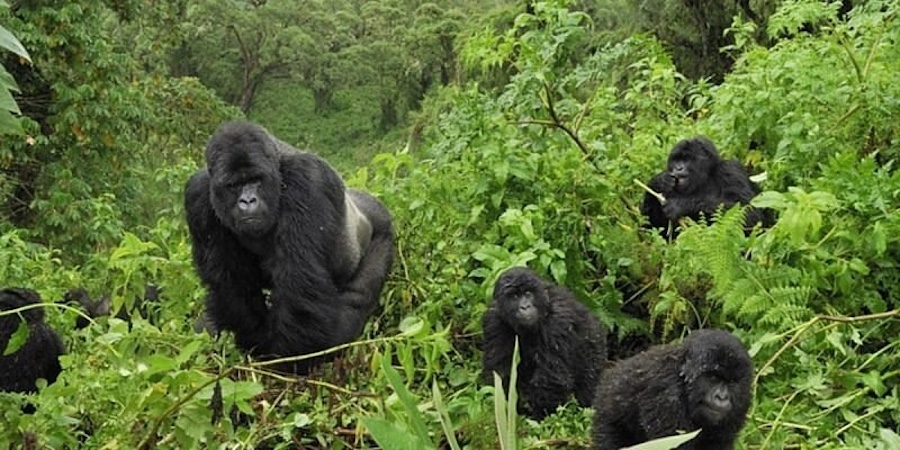There are two main species of gorillas in the world: eastern gorillas and western gorillas. These species are further divided into subspecies. Eastern gorillas include mountain gorillas and eastern lowland gorillas, while western gorillas are categorized into western lowland gorillas and cross river gorillas. These classifications are primarily based on the regions they inhabit. In this discussion, we’ll focus on mountain gorillas, a unique and critically endangered subspecies.
What Are Mountain Gorillas?
Mountain gorillas derive their name from the high-altitude, cool tropical forests they inhabit. Found in the mountainous regions of East Africa, their primary habitats are in the Virunga Massif—a shared area at the borders of Uganda, Rwanda, and the Democratic Republic of Congo—and Uganda’s Kigezi Highlands. Adapted to cooler climates, mountain gorillas are distinct from other gorilla subspecies due to their thick fur, which helps them survive in these colder environments.
The Threat of Extinction
Mountain gorillas are classified as an endangered species on the International Union for Conservation of Nature’s (IUCN) Red List. With only about 900 individuals left globally, their survival is precarious. Without active conservation efforts, these incredible primates could face extinction. Their importance extends beyond being iconic wildlife; they play a crucial role in their ecosystems and are a cornerstone of the regional tourism industry.
To combat the threat of extinction, both governmental and non-governmental organizations have rallied to protect mountain gorillas. Notable groups such as the Dian Fossey Gorilla Fund, Gorilla Doctors, and Friend a Gorilla have been instrumental in these efforts. They focus on activities like monitoring the health and well-being of gorillas, protecting them from poachers, and educating local communities about the gorillas’ ecological and economic significance.
Protected Habitats for Mountain Gorillas
One of the most significant steps in conservation has been the establishment of national parks to secure the gorillas’ habitats. This ensures that these primates do not compete for space with human settlements. Today, mountain gorillas can only be found in four protected areas:
Bwindi Impenetrable National Park (Uganda)
Mgahinga Gorilla National Park (Uganda)
Volcanoes National Park (Rwanda)
Virunga National Park (Democratic Republic of Congo)
These parks are vital sanctuaries where mountain gorillas live, forage, and interact. Thousands of tourists visit these parks annually, drawn by the chance to see these magnificent creatures in their natural environment.
The Experience of Gorilla Trekking
The most direct way to connect with mountain gorillas is through gorilla trekking tours, a thrilling activity that takes visitors deep into the forested mountains of East Africa. Trekking involves hiking through dense vegetation in search of a gorilla group. The journey can take anywhere from 2 to 6 hours, depending on the gorillas’ location on a given day.
Upon finding a group, visitors usually observe them for one hour. Gorillas typically live in family groups of 10-30 individuals, led by a dominant male known as the silverback. During the observation, trekkers can witness the gorillas’ fascinating behaviors, such as foraging, playing, and communicating in ways that often resemble human interaction.
For many, the highlight of this experience is capturing the gorillas on camera. These photos often serve as cherished memories of an encounter with one of nature’s most intelligent and awe-inspiring creatures.
Conservation Efforts and Challenges
While gorilla trekking has become a popular tourist activity, it also serves as a vital conservation tool. Revenue from gorilla trekking permits is reinvested into conservation programs and local communities. These funds support anti-poaching patrols, habitat restoration, and community projects that reduce human-wildlife conflict.
Despite these efforts, challenges persist. Habitat loss due to agricultural expansion, poaching, and disease transmission from humans remain significant threats to mountain gorillas. Conservation organizations work tirelessly to address these issues, often in collaboration with local communities who play a critical role in the gorillas’ survival.
Why You Should Visit
Visiting mountain gorillas is more than just a thrilling adventure; it is a way to support their conservation. By purchasing trekking permits, travelers contribute directly to the preservation of these endangered animals and their habitats. Moreover, encountering mountain gorillas in the wild fosters a deep appreciation for their intelligence, social structure, and the urgent need to protect them.
The opportunity to see mountain gorillas may not last forever. Their fragile population underscores the urgency of visiting them now, while also supporting the global effort to ensure their survival. As you hike through the lush, misty forests of East Africa and lock eyes with these majestic creatures, you’ll not only create unforgettable memories but also become part of a vital mission to save them from extinction.
Conclusion
Mountain gorillas are a symbol of strength and resilience, yet their survival is far from guaranteed. Conservation efforts have made remarkable strides, but the battle to protect these endangered primates is ongoing. Visiting the national parks where they live is not just an extraordinary experience—it is a chance to contribute to their future. Buy a tour package from a reputable safari operator or book a car rental in Uganda to visit their natural habitats and join the collective effort to ensure that mountain gorillas remain a living treasure for generations to come.


